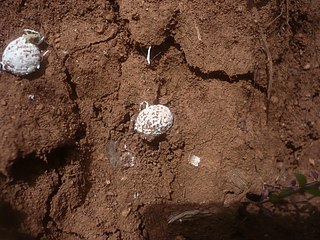
A basidium is a microscopic spore-producing structure found on the hymenophore of reproductive bodies of basidiomycete fungi. These bodies also called tertiary mycelia, which are highly coiled versions of secondary mycelia. The presence of basidia is one of the main characteristic features of the genus. A basidium usually bears four sexual spores called basidiospores. Occasionally the number may be two or even eight. Each reproductive spore is produced at the tip of a narrow prong or horn called a sterigma (pl. sterigmata), and is forcefully expelled at full growth.

The Phallales is an order of fungi in the subclass Phallomycetidae. The order contains two families: the Claustulaceae, and the Phallaceae, which, according to a 2008 estimate, collectively contain 26 genera and 88 species.
Gordon Herriot Cunningham, CBE, FRS was the first New Zealand-based mycologist and plant pathologist. In 1936 he was appointed the first director of the DSIR Plant Diseases Division. Cunningham established the New Zealand Fungal Herbarium, and he published extensively on taxonomy of many fungal groups. He is regarded as the 'Father' of New Zealand mycology.

The Gomphaceae are a diverse family of fungi belonging in what is classically known as the Phallales or cladistically as the gomphoid-phalloid clade. The family has 13 genera and 287 species.

The Gomphales are an order of basidiomycete fungi. Some or all families belonging to Gomphales have been sometimes included in the order Phallales, the now-obsolete Ramariaceae was also previously included in Cantharellales. Recent phylogenetic analyses include in Gomphales the families of the original description of the order by Walter Jülich, with addition of Clavariadelphaceae. According to one 2008 estimate, the Gomphales contain 18 genera and 336 species.

Gautieria is a genus of hypogeal fungi in the family Gomphaceae. They form mycorrhizae with various tree species, mostly from the family Pinaceae. Species are present over much of the world's temperate and boreal forest habitats. It is well documented that species from this genera are an important part of the diet of the northern flying squirrel. Also, some Australian marsupials, especially the rat-kangaroos, feed extensively on these fungi. The fungi also benefit from this relationship: not only do the squirrels help to disperse the spores and propagate the species, studies suggest that passage through the digestive tract of a mammal promotes germination of spores.

Gastrosporium is the sole genus in the fungal family Gastrosporiaceae. It contains two truffle-like species, the type G. simplex, and G. asiaticum. Both the family and genus were circumscribed by Italian mycologist Oreste Mattirolo in 1903.

Lysurus is a genus of fungi in the Phallaceae, a family known collectively as the stinkhorn fungi. The species have a widespread distribution, but are specially prevalent in tropical areas.

Pseudocolus fusiformis is a stinkhorn mushroom in the Phallaceae, a family well known for a remarkable range of fruit body types. It is the most widely distributed member of the genus Pseudocolus and has been found in the United States, Australia, Japan, Java, and the Philippines. It is commonly known as the stinky squid, because of its fetid odor, and its three or four upright "arms" which are connected at the top. The malodorous smell comes from the dark greenish slimy gleba covering the inside faces of the arms, and attracts insects that help to disperse the spores.

Clathrus columnatus, commonly known as the column stinkhorn, is a saprobic species of basidiomycete fungus in the family Phallaceae. It has a widespread distribution, and has been found in Africa, Australasia, and the Americas. It may have been introduced to North America with exotic plants. Similar to other stinkhorn fungi, the fruiting body, known as the receptaculum, starts out as a subterranean "egg" form. As the fungus develops, the receptaculum expands and erupts out of the protective volva, ultimately developing into mature structures characterized by two to five long vertical orange or red spongy columns, joined at the apex. The fully grown receptaculum reaches heights of 8 cm (3.1 in) tall. The inside surfaces of the columns are covered with a fetid olive-brown spore-containing slime, which attracts flies and other insects that help disseminate the spores. Although once considered undesirable, the fungus is listed as edible. It is found commonly in mulch.

Mycoacia is a genus of toothed crust fungi in the family Meruliaceae. It was circumscribed by Dutch mycologist Marinus Anton Donk in 1931.

Chondrostereum is a genus of fungi in the family Cyphellaceae. The type species, Chondrostereum purpureum, causes the disease called silver leaf.

Disciseda is a genus of gasteroid fungi in the family Agaricaceae. It is a widely distributed genus that is prevalent in arid zones. Disciseda was circumscribed by mycologist Vassiliĭ Matveievitch Czernajew in 1845.

Lopharia is a genus of fungi in the family Polyporaceae. The genus was circumscribed by Károly Kalchbrenner and Peter MacOwan in 1881.

Tyromyces is a genus of poroid fungi in the family Polyporaceae. It was circumscribed by mycologist Petter Karsten in 1881. The type species is the widely distributed Tyromyces chioneus, commonly known as the white cheese polypore. The phylogenetic position of Tyromyces within the Polyporales is uncertain, but it appears that it does not belong to the "core polyporoid clade". Tyromyces is polyphyletic as it is currently circumscribed, and has been described as "a dumping place for monomitic white-rot species with thin-walled spores."

Octaviania is a genus of truffle-like fungi in the family Boletaceae. The widespread genus is estimated to contain 15 species.

Claustula is a fungal genus in the family Claustulaceae. It is monotypic, containing the single truffle-like species Claustula fischeri, described in 1926 and found in New Zealand and Tasmania. In May 2016, it was one of two native New Zealand fungi added to the IUCN Red List of Threatened Species as endangered.

David Hunt Linder (1899–1946) was an American mycologist known for his work on the Helicosporous fungi and his dedications for the advancement of mycological knowledge. He curated the Farlow Herbarium of Cryptogamic Botany at Harvard University and founded a highly respected journal Farlowia.
Farysia is a genus of fungi belonging to the family Anthracoideaceae.

















